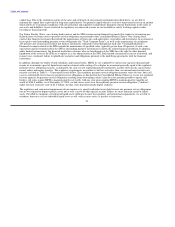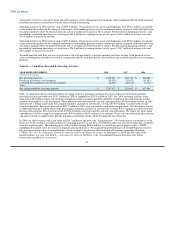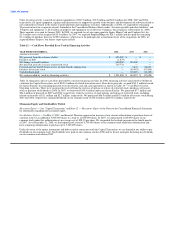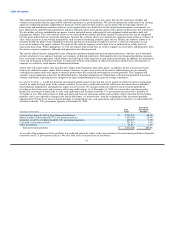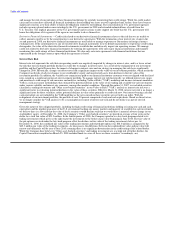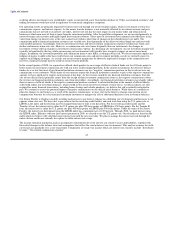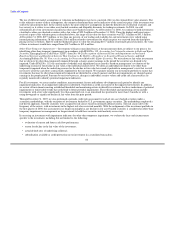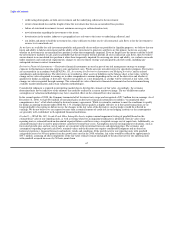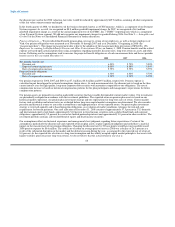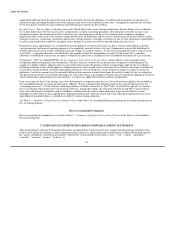MoneyGram 2008 Annual Report Download - page 62
Download and view the complete annual report
Please find page 62 of the 2008 MoneyGram annual report below. You can navigate through the pages in the report by either clicking on the pages listed below, or by using the keyword search tool below to find specific information within the annual report.
Table of Contents
Off-Balance Sheet Arrangements
Sale of Receivables — Through December 31, 2007, we had an agreement to sell undivided percentage ownership interests in certain
receivables, primarily from our money order agents, in an amount not to exceed $400.0 million. These receivables were sold to
commercial paper conduits (trusts) sponsored by a financial institution and represented a small percentage of the total assets in these
conduits. Our rights and obligations were limited to the receivables transferred, and were accounted for as sales transactions under
SFAS No. 140, Accounting for Transfers and Servicing of Financial Assets and Extinguishments of Liabilities. As a result, the assets and
liabilities associated with these conduits, including our sold receivables, were not recorded or included in our financial statements. The
business purpose of this agreement was to accelerate cash flow for investment. The receivables were sold at a discount based upon short-
term interest rates. In December 2007, we decided to cease selling receivables through a gradual reduction in the balances sold each
period. In January 2008, we terminated the facility and there is no balance of sold receivables as of December 31, 2008. The balance of
sold receivables as of December 31, 2007 was $239.0 million. Average receivables sold were $3.7 million and $349.9 million in 2008
and 2007, respectively. The expense of selling the agent receivables is included in the Consolidated Statements of (Loss) Income in
"Investment commissions expense" and totaled $0.2 million in 2008 compared to $23.3 million in 2007.
Special Purpose Entities — See Note 3 — Summary of Significant Accounting Policies of the Notes to Consolidated Financial Statements
for a discussion of our special purpose entities.
ENTERPRISE RISK MANAGEMENT
Risk is an inherent part of our business, particularly credit risk, interest rate risk, financial institution risk, liquidity risk, operational risk,
foreign currency exchange risk and regulatory risk. See Part 1, Item 1A "Risk Factors" for a description of the principal risks to our
business. The realignment of our portfolio in the first quarter of 2008, the Capital Transaction, the restructuring of our official check
business, the interest rate environment and the global macroeconomic environment had a significant impact on our business risks and our
risk management strategies in 2008. Our risk management objective is to monitor and control risk exposures to produce steady earnings
growth and long-term economic value. The extent to which we properly and effectively manage each of the various types of risk is
critical to our financial condition and profitability. Management implements policies approved by our Board of Directors that cover our
investment, capital, credit and foreign currency policies and strategies. The Board receives periodic reports regarding each of these areas
and approves significant changes to policy and strategy. An Asset/Liability Committee, comprised of senior management, routinely
reviews investment and risk management strategies and results. A Credit Committee, comprised of senior management, routinely reviews
credit exposure to our agents. Following is a discussion of the strategies we use to manage and mitigate the risks we have deemed most
critical to our business. While containing forward-looking statements related to risks and uncertainties, this discussion and related
analyses are not predictions of future events. MoneyGram's actual results could differ materially from those anticipated due to various
factors discussed under "Cautionary Statements Regarding Forward-Looking Statements."
Credit Risk
Credit risk, or the potential risk that we may not collect amounts owed to us, affects our business primarily through receivables,
investments and derivative financial instruments. In addition, the concentration of our cash, cash equivalents and investments at large
financial institutions exposes us to credit risk.
Financial Institution Risk — Our cash, cash equivalents and investments are concentrated at a few large financial institutions. These
institutions act as custodians for our asset accounts, serve as counterparties to our foreign currency transactions and conduct cash
transfers on our behalf for the purpose of clearing our payment instruments and related agent receivables and agent payables. Through
certain check clearing agreements and other contracts, we are required to utilize several of these financial institutions; in certain cases, we
are required to maintain pre-defined levels of cash, cash equivalents and investments at these financial institutions overnight. As a result
of the on-going credit market crisis, several financial institutions have faced capital and liquidity issues which led them to restrict credit
exposure.
59






